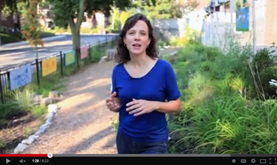EcoArtEd: Hilary Inwood's YouTube Channel
I'm starting to create a collection of short videos about artists' and childrens' environmental art installations in Toronto. The first tracks the eco-art collection at Runnymede PS in the west end of Toronto. The second features one of the art installations by Toronto artists Susan Schelle and Mark Gomes in the heart of Toronto.
 |
||||
| Environmental Art |
|
Eco-Art Education
Greening Art Education
This short handout provides art educators with a list of ways to begin making their classrooms more environmentally-friendly spaces. It describes strategies for 'greening' your art room, art program, pedagogy, school and community, as well as suggests strategies for eco-art education in general.
OISE's Eco-Art Collection
In recent years, I've been working with other OISE faculty and students to raise awareness and encourage action on Environmental and Sustainability Education through the creation of a series of environmental art installations. Some of these are part of the 'Take the Stairs' Campaign, that forms a walking art gallery in the main stairwell of the OISE building, encouraging our community to take the stairs, rather than elevators, (thereby conserving the energy of the elevators and improving the health and wellness of the walkers). The link to the OISE website provides photographs and a description of each of these installations.
Eco-Art Programs
Cape Farewell
Cape Farewll is an artist-led organization that brings together artists, creatives and scientists to raise awareness about climate change and the need to work towards a more sustainable society. Creativity is used as a means to not only communicate the challenges our world faces, but also devise innovative solutions to sustainability.
Stream of Dreams
This Canadian non-profit uses science and art as a means to help communities discover and care for their local watershed. They are best known for their vibrant fish murals, found on school fences all over North America.
Project FishNet
This two part project ('craft' and 'release') involved over a thousand school children in a "subtle form of protest art" in Toronto in 2008. Working with local artists, the students learned about the characteristics and challenges of Great Lakes fish species, resulting in the crafting of hundreds of individually painted textile fish. The fish, then 'released' into an exhibition and back into the schools, helped to raise awareness about the health of Lake Ontario fish, as well as raise money to support the Lake Ontario Waterkeepers and Great Lakes United, two charities devoted to reviving and protecting the Great Lakes bioregion and its fish stocks.
River of Words
Since 1996, River of Words has sponsored an international poetry and art contest on the theme of watersheds. The contest is open to students ages 5 through 19 anywhere in the world, and the winning entries are posted on their website, creating a huge database of childrens' eco-artworks.
Beehive Design Collective
The Beehive Design Collective is a "wildly motivated, all-volunteer, activist arts collective dedicated to 'cross-pollinating the grassroots' by creating collaborative, anti-copyright images for use as educational and organizing tools". Their large-scale, highly detailed murals, what they refer to as "visual tools", help to share stories related to social and eco-justice through visual, written and verbal forms of communication.
Environmental Education
Traditions of Environmental and Sustainability Education
Environmental Actions for Children
